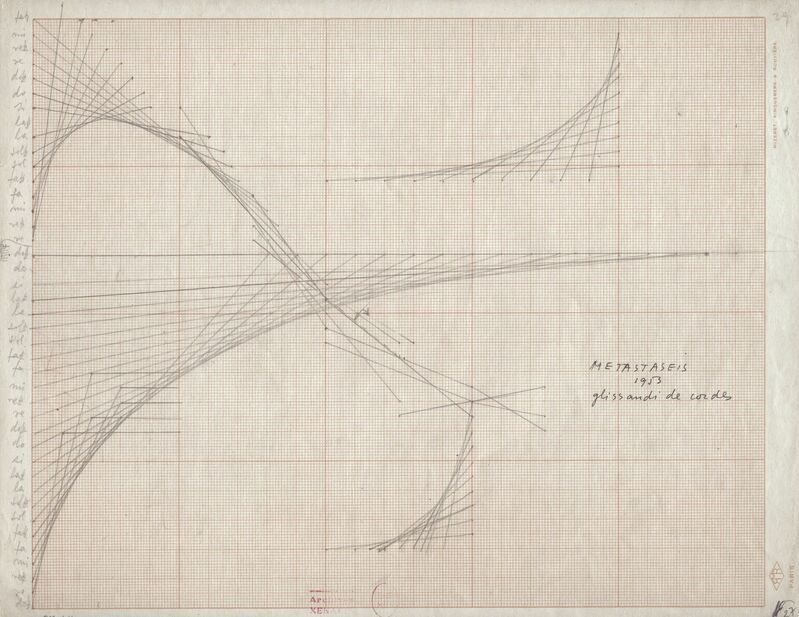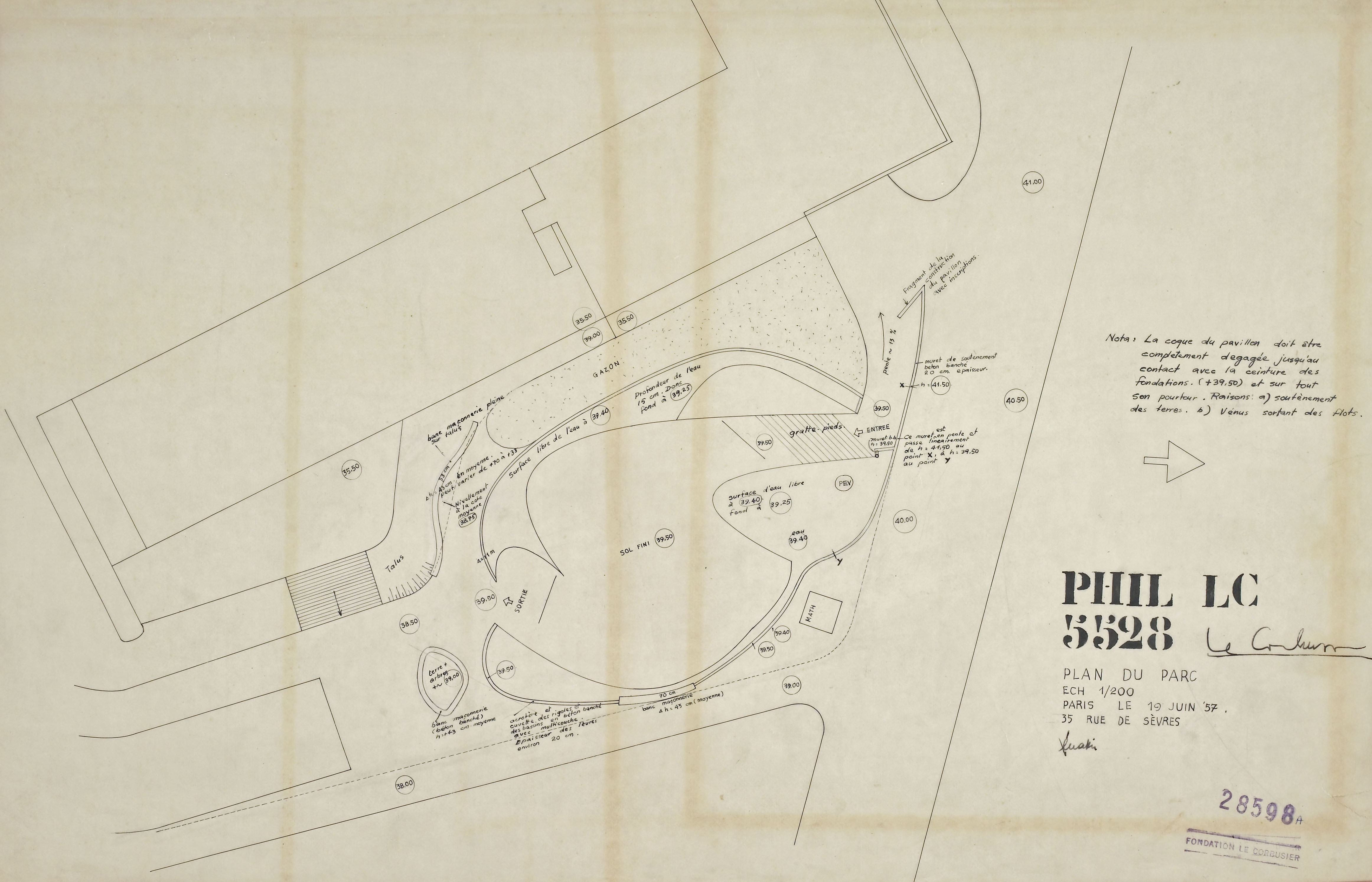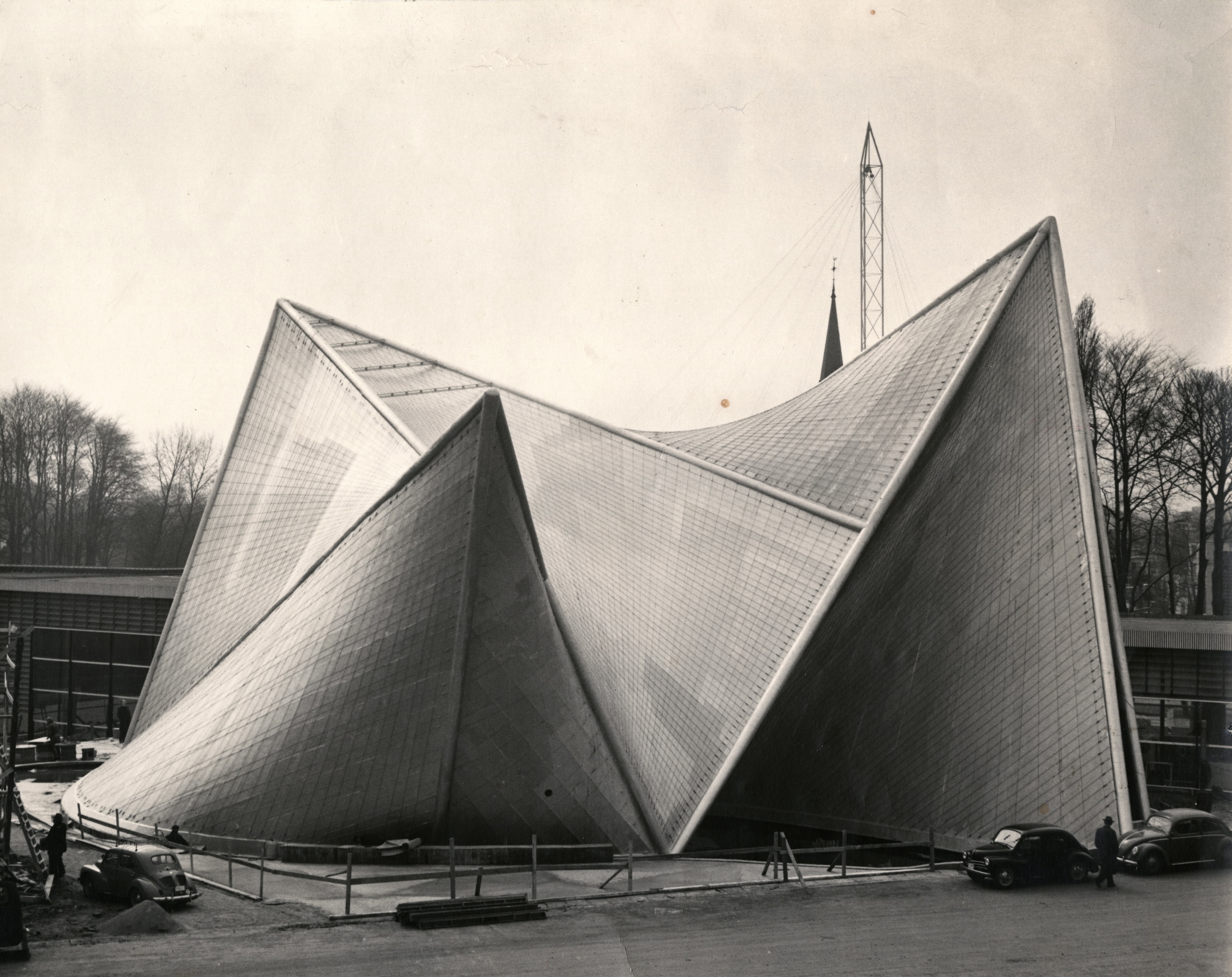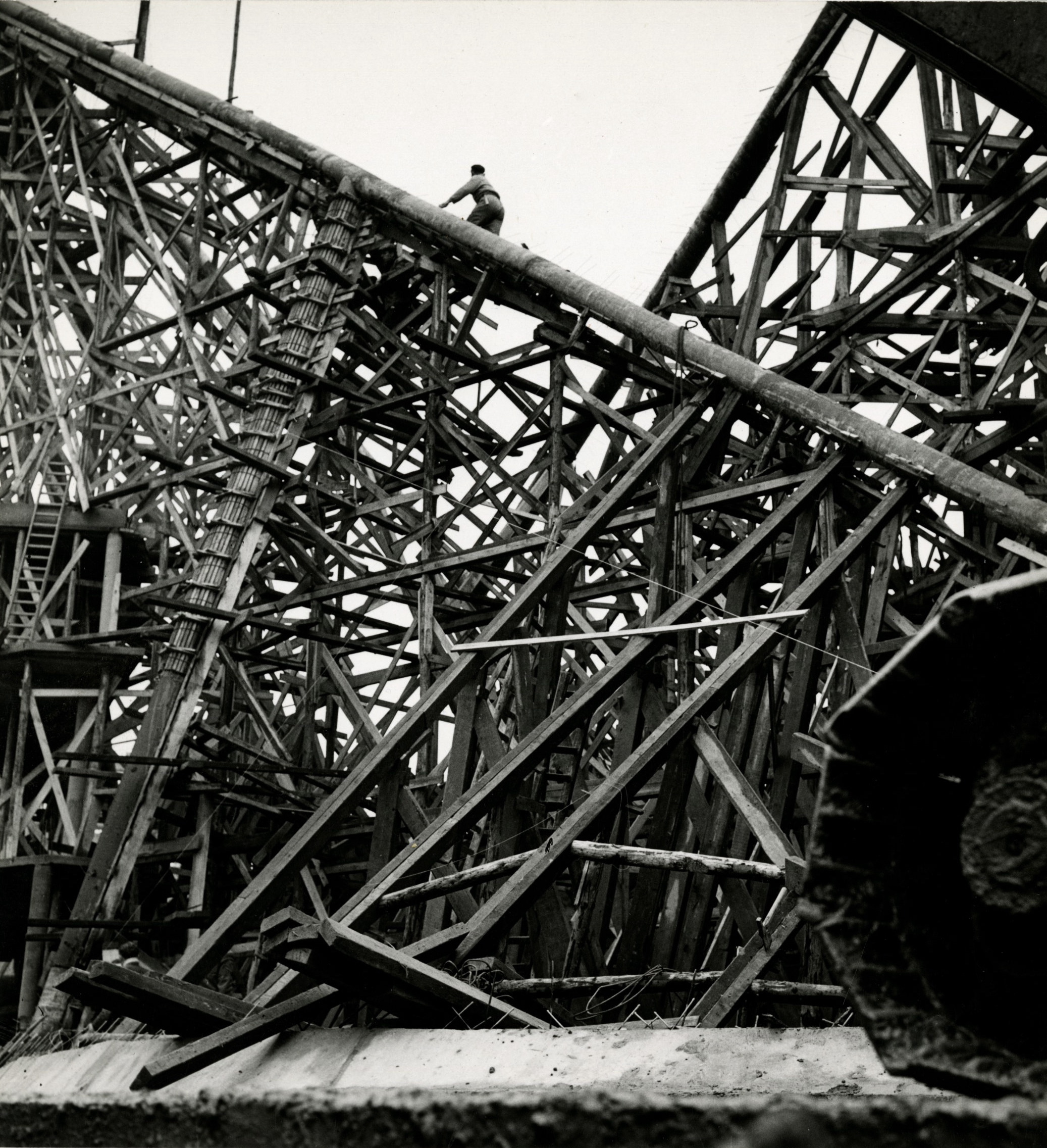
The Philips Pavilion at the 1958 Brussels World’s Fair is a building that applied sound as a main design element, thus creating the unique nature of the structure.[1] One part of this complex project was the “Poème Électronique”[2] by Le Corbusier and Edgar Varèse, which established the visual and acoustic reality of the pavilion’s interior. However, the real avant-garde characteristics of the project originated with the engineer, composer, and architect Iannis Xenakis.
In 1947, Xenakis arrived in Paris as a political refugee from Greece, where he ended up working as an engineer in Le Corbusier’s atelier for twelve years.[3] During this period, he pursued his dearest wish of becoming a composer while simultaneously acquiring knowledge of architectural design. This parallelism was ultimately distinguished by reciprocal influence. Moreover, his continual quest for continuities between art and science led to the discovery of a compositional and design-related explorative question, which Xenakis sought to solve in both his compositions and architecture.

© Xenakis Family Estate
The Philips Pavilion was intended to show the products of the company Philips, which had been developing technologies for sound and image reproduction since the 1930s, in use rather than as exhibition objects. Every twenty minutes, up to 500 people could visit a presentation of the “Poème Électronique”, an eight-minute synthesis of light, sound, image, color, rhythm, and architecture. Le Corbusier designed this space as a single interior with one entrance and one exit—similar to a stomach—which was completely secluded from the outside world. Modular surfaces five centimeters thick separated the interior from the exterior visually, and acoustically as well. The acoustics influenced the conception of the complex form significantly. Convex and concave surfaces were meant to reflect the reproduced sound in as many directions as possible, for “in order to control all possible spatial impression, reverberation should be reasonably low.”[4] The structure itself was built of nine hyperbolic paraboloids, projecting steeply up from the ground and leaning against each other and culminating at three points. Never before had such geometric surfaces, which display excellent static properties, been implemented in such a consistent way. The surfaces were executed in prefabricated, numbered modules, assembled on site with the aid of a supporting structure to arrive at their final form. Maintaining tension throughout the entire structure were steel cables anchored to the guiding lines of the paraboloids and later tautened.
Xenakis’s compositions “Metastaseis” (1953–54)[5] and “Pithoprakta” (1955–56), which represent a radical intervention in the history of musical composition, preceded the design of the pavilion. The point of departure for these pieces was Xenakis’s fascination with phenomena of mass sound resulting from heightened auditory experiences related to the Greek resistance during World War II and to natural phenomena like the chirping of cicadas.[6] His main interest was to record the nature and structure of these sound events,[7] which led to the objective of reconstructing these phenomena using other sonic means, through graphic and stochastic processes,[8] in order to achieve a formalization of sound characters. To this end, Xenakis first transferred architectural means of recording/drawing to the musical context, enabling him to intuitively put his ideas to paper, which he could not capture using conventional musical notation. Serving as a main tool in these notation processes were ideas from thermodynamics and stochastics. The recognition, calculation, and control of chaos structures was the subordinate goal that Xenakis integrated into his creative work. He repeatedly employed methods of making visible and set out to simulate phenomena that elude the human mind. Discoveries in the natural sciences held strong importance for him, including Brownian motion, kinetic theory of gases, or probability distribution curves, for they allowed him to realize his sound imaginings using his own methods. The probabilistic analysis of sound events, the mass projection of sound in different directions, and the speed at which tones continually change frequency (glissando) were all properties that Xenakis calculated with mathematical formulas. This allowed him to adapt the idea of a piece and precisely chart it in coordinate systems as points and graphs before going on to transcribe it using conventional musical notation. Xenakis applied a thermodynamic concept—change in temperature[9]—to describe the varying states of density in his compositions (Champs de densitée sonore), a property that is frequently cited when describing spatial quality.

The transversal appropriation of content and related methods was informed by Xenakis’s scientific exploration of physics, mathematics, and philosophy, thus laying a foundation for the experimental application of notational forms unrelated to architecture and composition, which nonetheless enabled him to develop both musical and architectural structures. With these notations allowing him to constantly navigate between composition and architecture, the uniqueness of the Philips Pavilion rose to the fore, with an evident intertwining of music and architecture. Therefore, in terms of structure, the pavilion materialized a highly complex field of influences and relations, which, in Xenakis’s recordings/drawings, made the inner nexuses of this building legible. The following statement by Hermann Scherchen applies, in equal measure, to Xenakis’s first avantgarde composition “Metastaseis” and the Philips Pavilion itself, describing the multifaceted character of the architectural structure: “In fact it does not come out of music at all, but from somewhere completely different.”[10]

© Fondation Le Corbusier/Bildrecht, Wien, 2016
Le Corbusier’s strong interest in the “Poème Électronique”, his keen travel activity which left him with little time, and his endeavor to conceptualize an architecture based on mathematics all led him to support Xenakis’s desire to design the building himself entirely. Up to that point, Xenakis’s primary work focus had been on finding and calculating static and structural solutions rather than on creating designs. The inclination to fully hand over the design process resulted from Le Corbusier’s trust and interest in Xenakis’s capabilities, especially resulting from the latter’s contributions to convent of La Tourette. Indeed, who if not Xenakis could better fulfill his aspirations to create an esthétique scientifique? For Xenakis it was an ideal opportunity to implement his experiments with sound and architecture on a single level, that is, to try them out in a project that seemed predestined for this purpose.

© Fondation Le Corbusier/Bildrecht, Wien, 2016
While in his compositions Xenakis developed his own methods, borrowing from architecture, mathematics, and physics, in the design of the pavilion he now embarked upon the opposite path by transferring these methods and this content to an architectural context. Here, again, he sought a syntax that would succeed in lending order to straight lines, which held great fascination for him. Xenakis’s interest in forms and—more broadly formulated—in a general morphology allowed him to discover just such a syntax in the mathematical construction of hyperbolic paraboloids: mathematical ruled surfaces engendered from skewed rectangles whose “generating” lines represent a whole sequence of straight lines in a row. The physical dimension of the order and equilibrium resulting from the chaos was here translated by Xenakis into the production of an artificial state of equilibrium of forces (self-supporting system). It is in this way that he was able to integrate the concept of harmony in architecture on a material level and thus redefine it. This resulted in a structure accomplished with the aid of descriptive geometry. Visually, it strongly departed from the traditional ideas of proportion such as the Golden Section and, due to its complexity, almost seemed to fall apart. “If there is an ‘intimate connection’ between it [the pavilion] and “Metastaseis”, it lies more in their particular way of resolving concept and formation, using geometry to structure relations of succession and simultaneity, than in a specific visual vocabulary.”[11]

© Philips Archives
Aside from this methodological concurrence of sound and design concept, the pavilion embodied an acoustic architecture par excellence. Edgar Varèse’s “Poème Électronique” and Iannis Xenakis’s “Interlude Sonore” were meant to be projected along the so-called “sound routes” (Routes Sonores) in order to generate all kinds of spatial effects. Despite this endeavor to create an artificially engendered and controlled sensorial environment, the design of the pavilion in no way ignored the aspiration to create architecture. On the contrary, it was precisely this aspiration which generated a form that was meant to facilitate—in as transdisciplinary and scientific of a way as possible—an ultimate spatial experience. The exploration of equilibrated structures was taken to an extreme here, arising from the perception of acoustic phenomena and leading to these auditive experiences while engaging with the architecture of the pavilion.

© Philips Archives
The architecture of the pavilion was thus a physical and sensorial medium through which sound as quality fostered an intrinsic relationship between humans and architecture on visual, acoustic, auditive, and material levels. From design methods to the point of acoustic realization, the project was informed by sound, a fact that significantly influenced the building design and gave rise to a convergence between sound, composition, and architecture.
Translation: Dawn Michelle d’Atri
[1] Extensive information of the project’s genesis is provided by Marc Treib, Space Calculated in Seconds: The Philips Pavilion, Le Corbusier, Edgard Varèse (Princeton, 1996).
[2] For Le Corbusier, it embodies the Synthèse des Arts.
[3] After 1959, Xenakis devoted his efforts solely to composition, with an exception of the “Polytopes”, several competitions, and private homes.
[4] Iannis Xenakis, “Genese de l’architecture du Pavillon,” Revue Technique Philips 1 (1958), p. 3.
[5] The most comprehensive analysis of this early work is found in André Baltensperger, Xenakis und die stochastische Musik: Komposition im Spannungsfeld von Architektur und Mathematik (Bern, 1996).
[6] Iannis Xenakis, Musique Architecture (Tournai, 1971), p. 26.
[7] Ibid.
[8] The concept of stochastic music is elucidated by Xenakis in Musiques Formelles (Paris, 1963).
[9] Xenakis was referencing physicists and mathematicians like Jacob Bernoulli, Andrej A. Markov, Daniel Bernoulli, Carl Friedrich Gauss, Ludwig Boltzmann, James C. Maxwell, Sim.on Denis Poisson, and Robert Brown.
[10] Hermann Scherchen cited from Nouritza Matossian, Xenakis (Lefkosia, 2005), p. 88.
[11] Joseph Clarke, “Iannis Xenakis and the Philips Pavilion,” The Journal of Architecture 2, no. 17 (2012), p. 221.